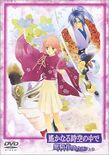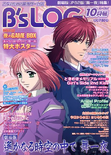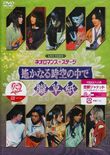This article is about the first game in the Harukanaru Toki no Naka de series. For the whole series, see Harukanaru Toki no Naka de (series).
Harukanaru Toki no Naka de (遙かなる時空の中で) is the first installment in the Haruka series, the starting title for the second and longest Neoromance IP. It is the game which receives the most outside coverage and spin-offs within the series. Yasuhiro Misawa is the main composer for the game.
Ruby Party created their first Japanese history-based IP, incorporating role-playing elements from their predecessor, Angelique, while maintaining simulation elements. They aimed to highlight the seasonal beauty of spring and summer through Heian aesthetics, a departure from their previous work.
The PlayStation Premium Box included a character clock while the Gameboy Advance boxed edition had a special pouch.
Plot[]
In spring 2000, a high school girl investigates occult rumors near their school. They are summoned to a parallel world resembling 10th-century Tokyo. As the White Dragon Priestess, they protect the capital from Onryou spirits and the Demon Clan, completing their divine duty before returning to their home world.
Gameplay[]
General[]
The player can name their protagonist, decide her birthday —subsequently her innate elemental property, and her starting default route during the prologue sequence. The main narrative is told over a period of three months in the span of ten chapters. Each chapter follows the basic story telling format.
- Introduction - voices the main objectives for the present chapter. A time limit is set which the player can choose to fulfill or ignore to progress the story. Locations dedicated to meeting story objectives have a shining golden border surrounding their selectable icon.
- Secondary story event - mandatory event which uses a day to view. Serves as a reminder for the chapter's current objective.
- Abstinence - placed in between the story events. The protagonist is required to take a mandatory break from her activities for one day. If desired, she can invite a single character to her side and talk with them during the day.
The protagonist can explore the capital with guardians to strengthen her Five Elements for combat. Each location is designated with an element, allowing her to visit three times. If free of vengeful spirits, she can play a memory matching game. Players can earn healing fuda or gifts for Abstinence days. She can also volunteer to rest for a day.
Combat[]
When a location has a blue flame icon hovering around it, it means it is currently being threatened by a vengeful spirit. Every place has a gauge for the revival rate and the spirit's difficulty level. The protagonist will be unable to visit the location until the spirit is vanquished, and combat initiates the moment the protagonist enters the area.
Battles are turn-based. Main party always acts first. Health bars at the top of the screen is for the enemy while the bottom bars are for the main party. Numerical values indicate a target's health. The optimum rating for the main party is 100 health while 0 health puts a character out of commission. Red numbers note that a target is nearly defeated. If the protagonist is knocked out, the battle will be lost.
The player only controls the protagonist's actions as her guardians attack automatically. At first, she can perform the following tasks:
- Flee (逃走) - choose to escape. May lower affinity with nearby partners.
- Attack (攻撃) - basic strike. Random chance of performing a critical hit.
- Fuda (札) - uses paper talismans the player has collected from mini games. Allows the priestess to heal the party or null status ailments.
- Magic (術) - both the priestess and the guardians can choose to hit their foe with a damaging spell. Requires a certain level of will power and Five Elements to use.
- Cheer (応援) - the priestess shouts words of encouragement to either one or both of her guardians. A favorable quote raises their will power, otherwise it may cause a drop. Will power, which is located above a character's health bar, is needed for magic.
After chapter five, the player can seal vengeful spirits to prevent their reemergence. Sealing requires weakened combat and meeting element cost. Characters can use talismans to strengthen themselves. The Five Elements' weaknesses and strengths affect combat, affecting opponents' abilities.
Character Routes[]
Each guardian has two ratings of affection for the protagonist, the "Trust" (信じる, shinjiru, ★ throughout the game) and "Feeling" (思う, omou, ★ throughout the game) stats. Opportunities to increase either bond are peppered within combat or during events in the main story. A favorable response is indicated by rising stars while negative reactions show lowering stars. A guardian with a high Trust or Feeling bond is more likely to personally visit the protagonist and offer their company for the day.
The protagonist may experience a romance event with a guardian, requiring the player to choose text options. Success often depends on favorable responses. Sub events can occur by visiting specific places, earning unique cheer quotes. Guardians have two romance routes: Normal Route, where the player collects Heart Pieces, and Other Route, where the main story proceeds on the "Heaven" or "Earth" path. Failure can cut off bonds and characters.
| Story Path | Normal Route only | Other Route only |
|---|---|---|
| Heaven (天) | Yorihisa, Inori, Takamichi, Eisen | Tenma, Shimon, Tomomasa, Yasuaki |
| Earth (地) | Tenma, Shimon, Tomomasa, Yasuaki | Yorihisa, Inori, Takamichi, Eisen |
Characters who are viable for the Other Route need at least two Heart Pieces gathered before chapter five. Other Routes present different events and images than a character's Normal Route. Activating this route negates the need to find the rest of said character's Heart Pieces.
Ran and Fujihime have hidden conditions for viewing their endings. Events for these characters are counted as "Friendship Events". Like romance events, their personal scenes drain a day of the protagonist's schedule in order to view. Players are encouraged to use their time wisely if they wish to view multiple endings in a single playthrough.
Modes[]
New Game[]
Self-explanatory.
Continue[]
Load from a previous save.
Bonus[]
Includes a gallery, music selection, in-game dictionary, and extra side stories. Gallery includes any still images and animated movies the player has earned in their playthrough(s). Side stories are unlocked once the player finishes the game once. Endings that have been obtained can also be heard/read again. Each character has a voiced soliloquy which can be viewed after completing their personal events.
Settings[]
Lets the player adjust the speed in which text is displayed on screen and the volume for sound effects, music, and voices. If these settings are changed before starting a new game, they will automatically be in effect.
Characters[]
A character's true age is one year less than their profile due to archaic recording, excluding modern characters from the parallel world where birth year counts as first year alive.
White Dragon Priestess and Eight Guardians[]
- Akane Motomiya
- Yorihisa Minamoto
- Tenma Morimura
- Inori
- Shimon Nagareyama
- Takamichi Fujiwara
- Tomomasa Tachibana
- Eisen
- Yasuaki Abe
Star Clan[]
- Fujihime
Demon Clan[]
Differences between ports[]
- The GBA version omits the PS animated opening and a majority of the in-game character animations.
- Characters are unvoiced in the GBA version.
- Ending credits are different between both ports.
Spin-Offs[]
- Koei 2002 Spring Pack Harukanaru Toki no Naka de 2/Harukanaru Toki no Naka de - repackaged as a part of Koei's 2002 Spring Sale. Received a 2002 clear file and 2 Haruka 2 postcards with purchase.
- Harukanaru Toki no Naka de Premium Box Complete - Premium Box of the PS version repackaged with five other Haruka titles
- Harukanaru Toki no Naka de Banjoyuugi
- Harukanaru Toki no Naka de Hachiyoushou
- Harukanaru Toki no Naka de Iroetebako
- Harukanaru Toki no Naka de Maihitoyo
- Harukanaru Toki no Naka de Yume no Ukihashi
- Hyakuman-nin no Harukanaru Toki no Naka de
Related Media[]
Designer brand Rubipa de July~ created charms, rings, and other jewelery symbolizing characters appearing in this game. Gamecity offers an incense set dedicated to particular scents favored by characters. The incense set doubles as a tribute to the Heian period's history of aesthetics, said to include aromas as a pivotal element of beauty. Decorative boxes can still be purchased as a part of the series's set. For a limited time, miniature character stickers, post cards, and a trading card game published by Bandai were on sale. Cospatio re-created Akane's priestess outfit and school uniform, but it is currently sold out.
Several publications and CDs were published for the game. Free samples of the fan made four panel comics can be read online at Gamecity. Two light novels for the game were authored by Fumie Kondoh featuring illustrations by Kuu Kitahara. Free samples of these books can be read at Gamecity Bunko.
Yumeta Company (TYO Animations) produced a two part OVA called Harukanaru Toki no Naka de ~Ajisai Yumekatari~, which is the first Haruka animated project. Kenichi Ohnuki, the same animation director for the game, returned to do work for the OVA. Its story is original and unique to itself. The opening and ending songs (Sakura Fubuki and Shura) were made by DASEIN.
Koei produced two computer softwares based on the title: Koi Emaki (desktop accessory) and Koi Tsuzuri (mailing software). Both programs can run on Windows '95~'98 OS and contained digital copies of the character portraits, audio files, and event stills used in the game.
The series's comic, which is localized by Viz Media as Haruka -Beyond the Stream of Time-, is created by Tohko Mizuno. It was the first comic adaptation of the company to debut before the game's actual release date, beginning its serialization in LaLa in December 1999. An animated TV series (Hachiyoushou), and an animated movie and live stage production (Maihitoyo) were created using the comic's influences. These mediums are roughly based on the first Haruka's events and characters.
Harukanaru Toki no Naka de ~Oborosoushi~, the second Haruka theatrical production and a project to celebrate the fifteenth anniversary of the Neoromance series, is an original story which stars a highly popular character of the game, Yasuaki. While he is imprisoned by the Demon Clan, the nature of his creation and emerging humanity are questioned throughout the plot. A secondary event to thank attending fans and a live event to celebrate the DVD publication were held by the theatrical group after the shows ended. Oborosoushi actor interviews and costume diagrams were featured in Dengeki Layers and Layers Bible, along with an overall coverage of the Haruka series up to that point. The narrative was adapted into a light-novel authored by Mashiro Yabuki and illustrated by Kuu Kitahara. Other merchandise made specifically for the theatrical production can be viewed on the official website.
During the renewal of the theatrical production, attendees could listen to a new Yasuaki image song. Fans could purchase the song on a Premium CD offered at the theater hall. A different epilogue for the play was presented depending on the day.
It is one of many titles represented in the October 21~November 3, 2014 Marui One Family Mizoguchi Koei-Tecmo Goods Fair.
Image Song[]
- orange
- Performed by JET SETS
Ending song (PS only).
Allusions[]
- A remixed version of the game's main theme (Harukanaru Toki no Naka de) can be learned and played by the protagonist in Kiniro no Corda.
- Characters and music from this game are referenced in That's QT.
Gallery[]
External Links[]
- Official product page, Official PS website, Official GBA website
- Premium Box Complete listing
- PS Opening movie
- Girls Style Oborosoushi report, 『ネオロマンス・ステージ-遙かな Presepe Oborosoushi report
| Harukanaru Toki no Naka de • Banjoyuugi • Hachiyoushou • Iroetebako • Maihitoyo • Pocket Scenario Series • 100man-nin |
| Harukanaru Toki no Naka de 2 |
| Harukanaru Toki no Naka de 3 • Izayoiki • Unmei no Labyrinth |
| Harukanaru Toki no Naka de Yume no Ukihashi |
| Harukanaru Toki no Naka de 4 |
| Harukanaru Toki no Naka de 5 • Kazahanaki |
| Harukanaru Toki no Naka de 6 • Gentou Rondo |
| Harukanaru Toki no Naka de 7 |
| Characters |
| Harukanaru Toki no Naka de |
| Akane Motomiya • Yorihisa Minamoto • Tenma Morimura • Inori • Shimon Nagareyama • Takamichi Fujiwara • Tomomasa Tachibana • Eisen • Yasuaki Abe • Fujihime • Akram • Iqtidar • Shirin • Sefr • Ran |
| Harukanaru Toki no Naka de Maihitoyo |
| Suefumi Oono |
| 100man-nin no Harukanaru Toki no Naka de |
| Kotengu • Youko • Mamedamuki |
| Harukanaru Toki no Naka de 2 |
| Karin Takakura • Yoritada Minamoto • Katsuzane Taira • Isato • Akifumi • Yukitaka Fujiwara • Hisui • Motomi Minamoto • Yasutsugu Abe • Yukari Fujiwara • Misono Fujiwara • Chitose Taira • Kazuhito • Tokitomo Minamoto |
| Harukanaru Toki no Naka de 3 |
| Nozomi Kasuga • Masaomi Arikawa • Yoshitsune Minamoto • Hinoe • Benkei Musashibou • Yuzuru Arikawa • Kagetoki Kajiwara • Atsumori Taira • Ridvan • Saku Kajiwara • Hakuryu • Yoritomo Minamoto • Masako Hojo • Kiyomori Taira • Tomomori Taira • Tsunemasa Taira • Koremori Taira • Tadanori Taira • Nii no Ama • Emperor Antoku |
| Harukanaru Toki no Naka de 3 Izayoiki |
| Shirogane • Hidehira Fujiwara • Yasuhira Fujiwara |
| Harukanaru Toki no Naka de 3 Unmei no Labyrinth |
| Phantom |
| Harukanaru Toki no Naka de Yume no Ukihashi |
| Beidou Xingjun • Nandou Xingjun |
| Harukanaru Toki no Naka de 4 |
| Chihiro Ashihara • Kazahaya • Asvin • Sazaki • Nagi • Futsuhiko • Hiiragi • Tooya • Oshihito Katsuragi • Iwanagahime • Michiomi Ootomo • Ayuki • Yuugiri • Raja • Nasatya • Shani • Ribhu • Mudgala • Karigane • Sainokimi |
| Harukanaru Toki no Naka de 5 |
| Yuki Hasumi • Shun Kiryu • Ryouma Sakamoto • Chinami • Souji Okita • Tatewaki Komatsu • Ouchi Fukuchi • Ernest Satow • Shinsaku Takasugi • Miyako Yakumo • Amami • Four Gods • Sou Kiryu • Isami Kondou • Toshizou Hijikata • Kaishu Katsu • Shintarou Nakaoka • Makoto • Takamori Saigou • Kogorou Katsura |
| Harukanaru Toki no Naka de 5 Kazahanaki |
| Rindou • Tadayoshi Oguri |
| Harukanaru Toki no Naka de 6 |
| Azusa Takatsuka • Hajime Arima • Darius • Kohaku • Shuhei Katagiri • Rudkhane • Masatora Honjo • Kudan Hagio • Murasame Satoya • Chiyo Komano • Seishiro Katagiri |
| Harukanaru Toki no Naka de 6 Gentou Rondo |
| Man • Naoya Toudou |
| Harukanaru Toki no Naka de 7 |
| Nanao Amano • Yukimura Sanada • Satsuki Amano • Musashi Miyamoto • Yamato Sasaki • Nagamasa Kuroda • Kanetsugu Naoe • Okuni • Munenori Yagyū |
| Other Information |
| Sub Characters • Series Terminology • Walkthroughs |









